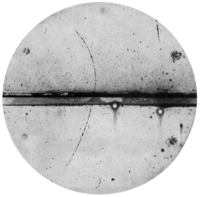
Photo from wikipedia
We investigate a pump‐probe X‐ray Thomson scattering (XRTS) experiment that might be carried out at a free electron laser facility to study warm‐to‐hot states of dense matter. Ultrashort and intense… Click to show full abstract
We investigate a pump‐probe X‐ray Thomson scattering (XRTS) experiment that might be carried out at a free electron laser facility to study warm‐to‐hot states of dense matter. Ultrashort and intense X‐ray pulses with different energies (1,560–1,830 eV) heat a 1 µm thick Al target isochorically and create homogeneous and uncompressed warm‐to‐hot states of dense matter. A second pulse with variable delay probes this heated state via XRTS. The X‐ray laser–target interaction is modelled within radiation‐hydrodynamic simulations applying the HELIOS‐CR code. The HELIOS‐CR results qualitatively agree with Monte‐Carlo simulations, where the laser pulse absorption is simulated based on a uniform random sequence of events. The electron feature in the simultaneously observed X‐ray scattering spectrum is a function of the degree of ionization and the target temperature. Therefore, the temporal evolution of the plasmon peak measures the ionization dynamics on ultra‐short time scales. The XRTS spectrum is calculated based on the Chihara formula utilizing the Born‐Mermin approximation for the free electron dynamic structure factor. The proposed experiment will reveal important details of the ionization dynamics on ultra‐short time scales as well as of the relaxation on ps time scales.
Journal Title: Contributions to Plasma Physics
Year Published: 2019
Link to full text (if available)
Share on Social Media: Sign Up to like & get
recommendations!